Academic Writing Report: Exploring Gap Year for High School Graduates
VerifiedAdded on 2023/01/13
|7
|1672
|37
Report
AI Summary
This academic writing report delves into the practice of academic writing, emphasizing its clarity, structure, and evidence-based approach. The report is divided into two parts: Part A outlines a plan for responding to a question, and Part B presents a reasoned response. The core question examines the trend of encouraging students to take a gap year after high school, exploring its advantages and disadvantages. The report defines key terms like "gap year" and identifies the target audience as high school graduates. Part A focuses on planning, including identifying the audience, researching relevant topics, and organizing information. Part B provides a detailed analysis of the gap year concept, discussing reasons for its popularity, such as increased world exposure and career exploration opportunities. The report highlights advantages like increased independence and career exploration, while also addressing potential disadvantages such as delayed education and financial constraints. The conclusion synthesizes the findings, emphasizing the importance of academic writing and the need for students to carefully consider the benefits and drawbacks of a gap year based on their individual career preferences.
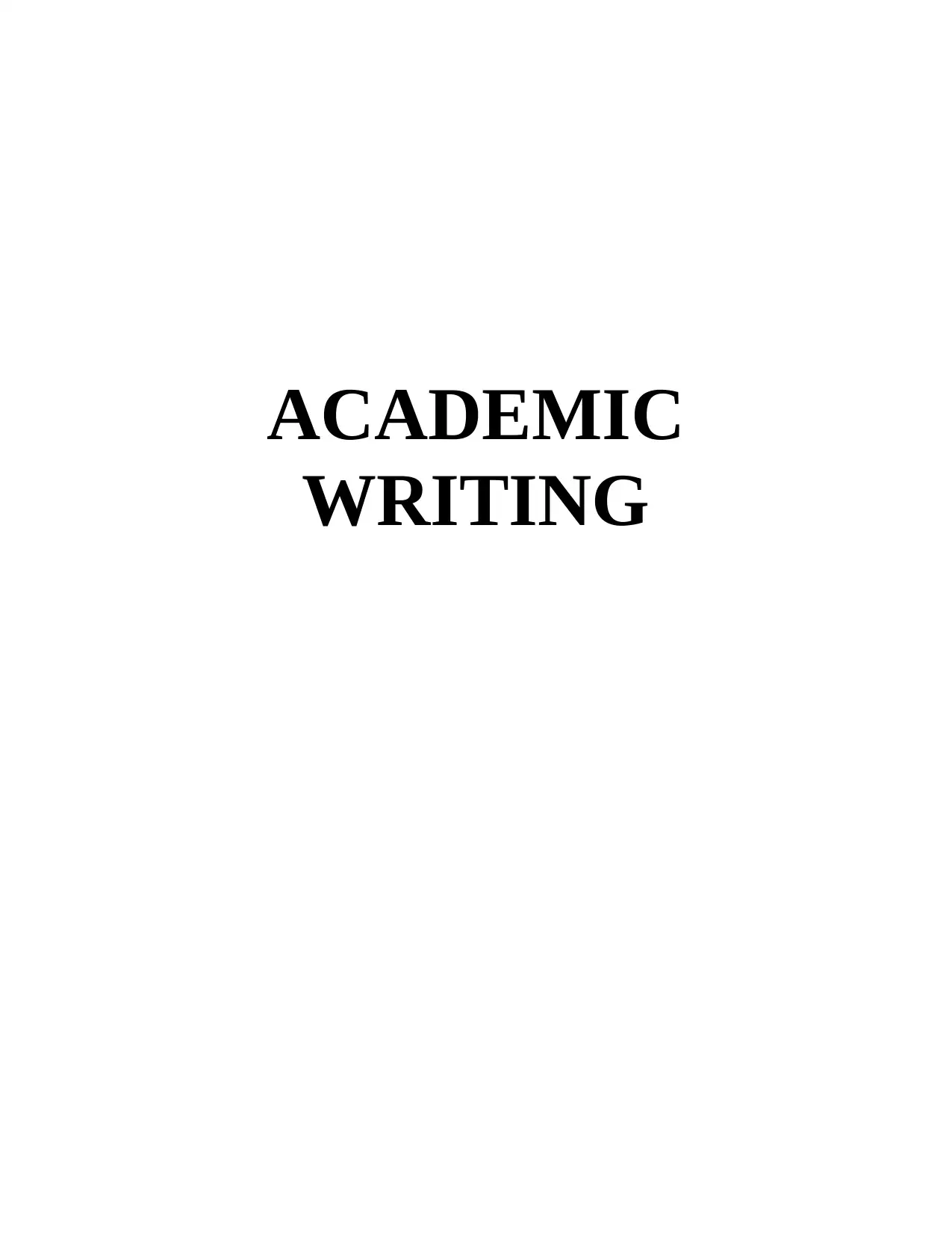
ACADEMIC
WRITING
WRITING
Paraphrase This Document
Need a fresh take? Get an instant paraphrase of this document with our AI Paraphraser
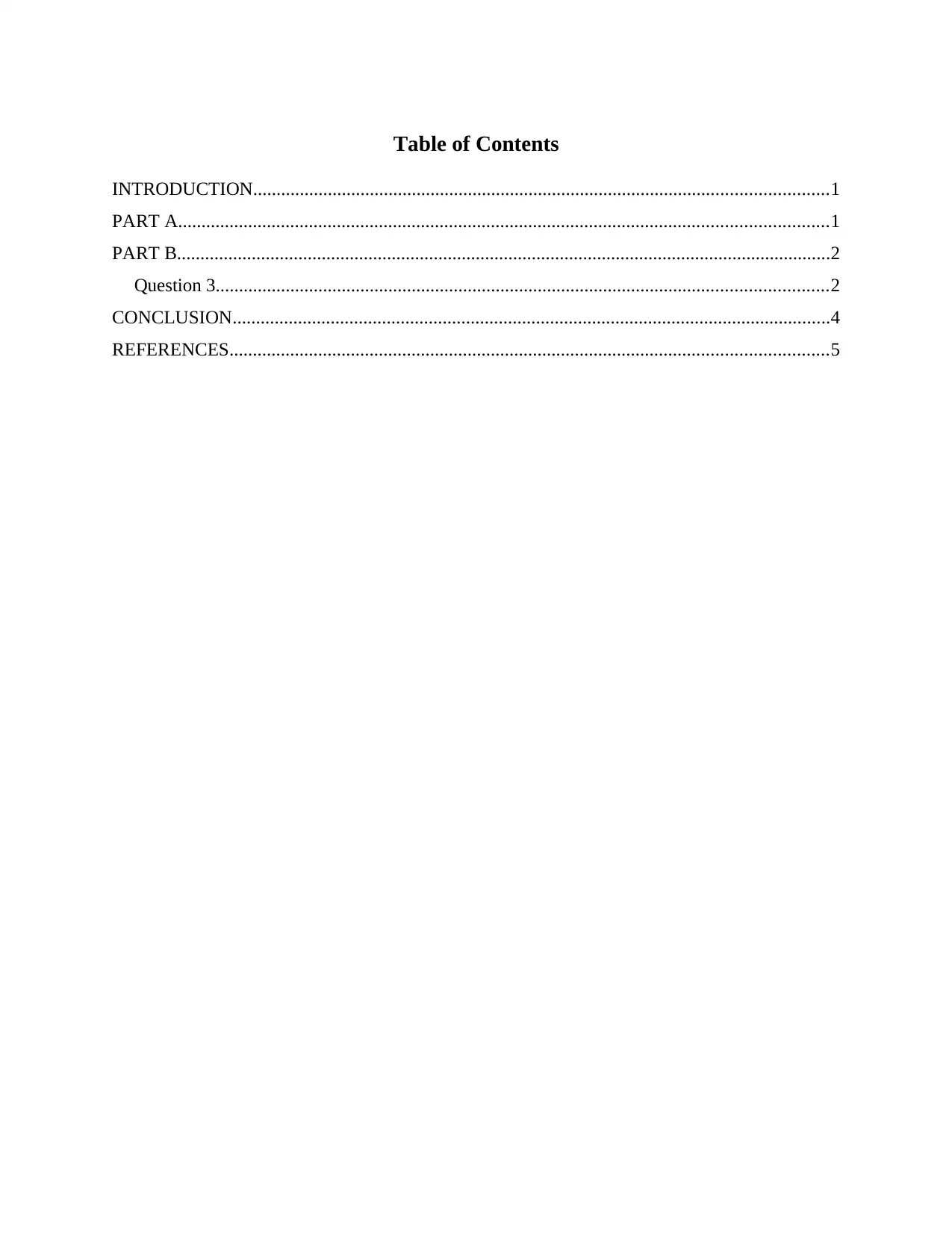
Table of Contents
INTRODUCTION...........................................................................................................................1
PART A...........................................................................................................................................1
PART B............................................................................................................................................2
Question 3...................................................................................................................................2
CONCLUSION................................................................................................................................4
REFERENCES................................................................................................................................5
INTRODUCTION...........................................................................................................................1
PART A...........................................................................................................................................1
PART B............................................................................................................................................2
Question 3...................................................................................................................................2
CONCLUSION................................................................................................................................4
REFERENCES................................................................................................................................5
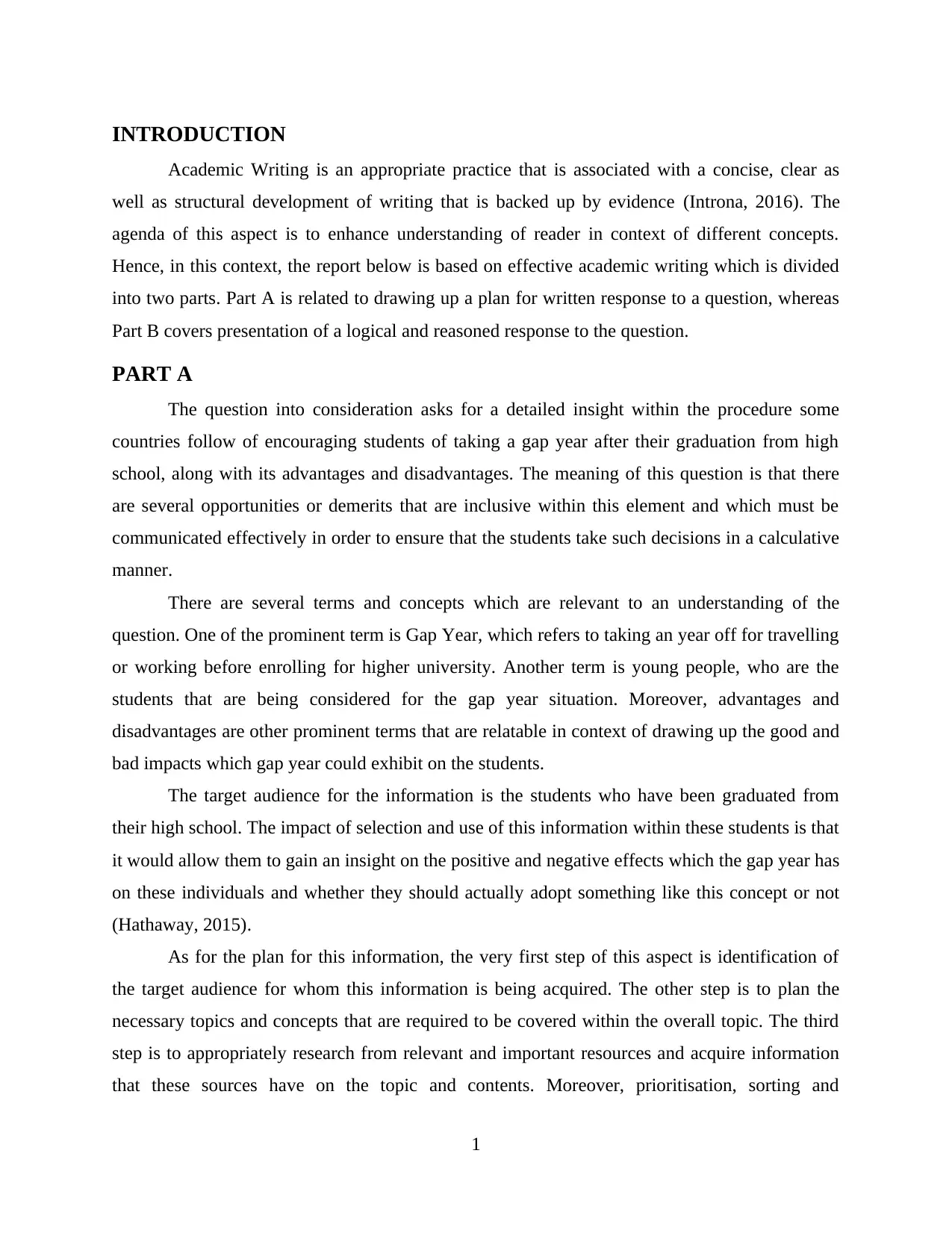
INTRODUCTION
Academic Writing is an appropriate practice that is associated with a concise, clear as
well as structural development of writing that is backed up by evidence (Introna, 2016). The
agenda of this aspect is to enhance understanding of reader in context of different concepts.
Hence, in this context, the report below is based on effective academic writing which is divided
into two parts. Part A is related to drawing up a plan for written response to a question, whereas
Part B covers presentation of a logical and reasoned response to the question.
PART A
The question into consideration asks for a detailed insight within the procedure some
countries follow of encouraging students of taking a gap year after their graduation from high
school, along with its advantages and disadvantages. The meaning of this question is that there
are several opportunities or demerits that are inclusive within this element and which must be
communicated effectively in order to ensure that the students take such decisions in a calculative
manner.
There are several terms and concepts which are relevant to an understanding of the
question. One of the prominent term is Gap Year, which refers to taking an year off for travelling
or working before enrolling for higher university. Another term is young people, who are the
students that are being considered for the gap year situation. Moreover, advantages and
disadvantages are other prominent terms that are relatable in context of drawing up the good and
bad impacts which gap year could exhibit on the students.
The target audience for the information is the students who have been graduated from
their high school. The impact of selection and use of this information within these students is that
it would allow them to gain an insight on the positive and negative effects which the gap year has
on these individuals and whether they should actually adopt something like this concept or not
(Hathaway, 2015).
As for the plan for this information, the very first step of this aspect is identification of
the target audience for whom this information is being acquired. The other step is to plan the
necessary topics and concepts that are required to be covered within the overall topic. The third
step is to appropriately research from relevant and important resources and acquire information
that these sources have on the topic and contents. Moreover, prioritisation, sorting and
1
Academic Writing is an appropriate practice that is associated with a concise, clear as
well as structural development of writing that is backed up by evidence (Introna, 2016). The
agenda of this aspect is to enhance understanding of reader in context of different concepts.
Hence, in this context, the report below is based on effective academic writing which is divided
into two parts. Part A is related to drawing up a plan for written response to a question, whereas
Part B covers presentation of a logical and reasoned response to the question.
PART A
The question into consideration asks for a detailed insight within the procedure some
countries follow of encouraging students of taking a gap year after their graduation from high
school, along with its advantages and disadvantages. The meaning of this question is that there
are several opportunities or demerits that are inclusive within this element and which must be
communicated effectively in order to ensure that the students take such decisions in a calculative
manner.
There are several terms and concepts which are relevant to an understanding of the
question. One of the prominent term is Gap Year, which refers to taking an year off for travelling
or working before enrolling for higher university. Another term is young people, who are the
students that are being considered for the gap year situation. Moreover, advantages and
disadvantages are other prominent terms that are relatable in context of drawing up the good and
bad impacts which gap year could exhibit on the students.
The target audience for the information is the students who have been graduated from
their high school. The impact of selection and use of this information within these students is that
it would allow them to gain an insight on the positive and negative effects which the gap year has
on these individuals and whether they should actually adopt something like this concept or not
(Hathaway, 2015).
As for the plan for this information, the very first step of this aspect is identification of
the target audience for whom this information is being acquired. The other step is to plan the
necessary topics and concepts that are required to be covered within the overall topic. The third
step is to appropriately research from relevant and important resources and acquire information
that these sources have on the topic and contents. Moreover, prioritisation, sorting and
1
⊘ This is a preview!⊘
Do you want full access?
Subscribe today to unlock all pages.

Trusted by 1+ million students worldwide
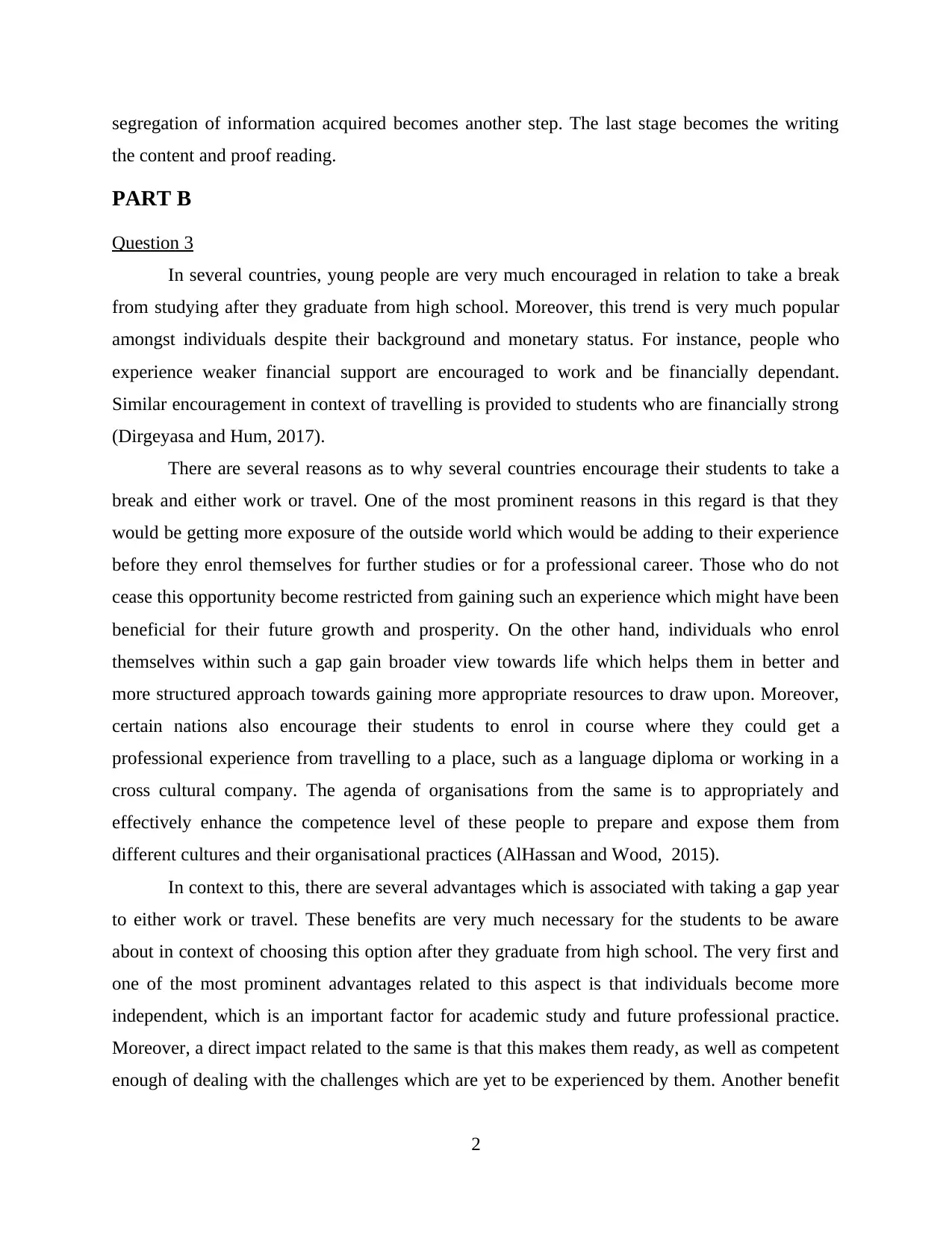
segregation of information acquired becomes another step. The last stage becomes the writing
the content and proof reading.
PART B
Question 3
In several countries, young people are very much encouraged in relation to take a break
from studying after they graduate from high school. Moreover, this trend is very much popular
amongst individuals despite their background and monetary status. For instance, people who
experience weaker financial support are encouraged to work and be financially dependant.
Similar encouragement in context of travelling is provided to students who are financially strong
(Dirgeyasa and Hum, 2017).
There are several reasons as to why several countries encourage their students to take a
break and either work or travel. One of the most prominent reasons in this regard is that they
would be getting more exposure of the outside world which would be adding to their experience
before they enrol themselves for further studies or for a professional career. Those who do not
cease this opportunity become restricted from gaining such an experience which might have been
beneficial for their future growth and prosperity. On the other hand, individuals who enrol
themselves within such a gap gain broader view towards life which helps them in better and
more structured approach towards gaining more appropriate resources to draw upon. Moreover,
certain nations also encourage their students to enrol in course where they could get a
professional experience from travelling to a place, such as a language diploma or working in a
cross cultural company. The agenda of organisations from the same is to appropriately and
effectively enhance the competence level of these people to prepare and expose them from
different cultures and their organisational practices (AlHassan and Wood, 2015).
In context to this, there are several advantages which is associated with taking a gap year
to either work or travel. These benefits are very much necessary for the students to be aware
about in context of choosing this option after they graduate from high school. The very first and
one of the most prominent advantages related to this aspect is that individuals become more
independent, which is an important factor for academic study and future professional practice.
Moreover, a direct impact related to the same is that this makes them ready, as well as competent
enough of dealing with the challenges which are yet to be experienced by them. Another benefit
2
the content and proof reading.
PART B
Question 3
In several countries, young people are very much encouraged in relation to take a break
from studying after they graduate from high school. Moreover, this trend is very much popular
amongst individuals despite their background and monetary status. For instance, people who
experience weaker financial support are encouraged to work and be financially dependant.
Similar encouragement in context of travelling is provided to students who are financially strong
(Dirgeyasa and Hum, 2017).
There are several reasons as to why several countries encourage their students to take a
break and either work or travel. One of the most prominent reasons in this regard is that they
would be getting more exposure of the outside world which would be adding to their experience
before they enrol themselves for further studies or for a professional career. Those who do not
cease this opportunity become restricted from gaining such an experience which might have been
beneficial for their future growth and prosperity. On the other hand, individuals who enrol
themselves within such a gap gain broader view towards life which helps them in better and
more structured approach towards gaining more appropriate resources to draw upon. Moreover,
certain nations also encourage their students to enrol in course where they could get a
professional experience from travelling to a place, such as a language diploma or working in a
cross cultural company. The agenda of organisations from the same is to appropriately and
effectively enhance the competence level of these people to prepare and expose them from
different cultures and their organisational practices (AlHassan and Wood, 2015).
In context to this, there are several advantages which is associated with taking a gap year
to either work or travel. These benefits are very much necessary for the students to be aware
about in context of choosing this option after they graduate from high school. The very first and
one of the most prominent advantages related to this aspect is that individuals become more
independent, which is an important factor for academic study and future professional practice.
Moreover, a direct impact related to the same is that this makes them ready, as well as competent
enough of dealing with the challenges which are yet to be experienced by them. Another benefit
2
Paraphrase This Document
Need a fresh take? Get an instant paraphrase of this document with our AI Paraphraser
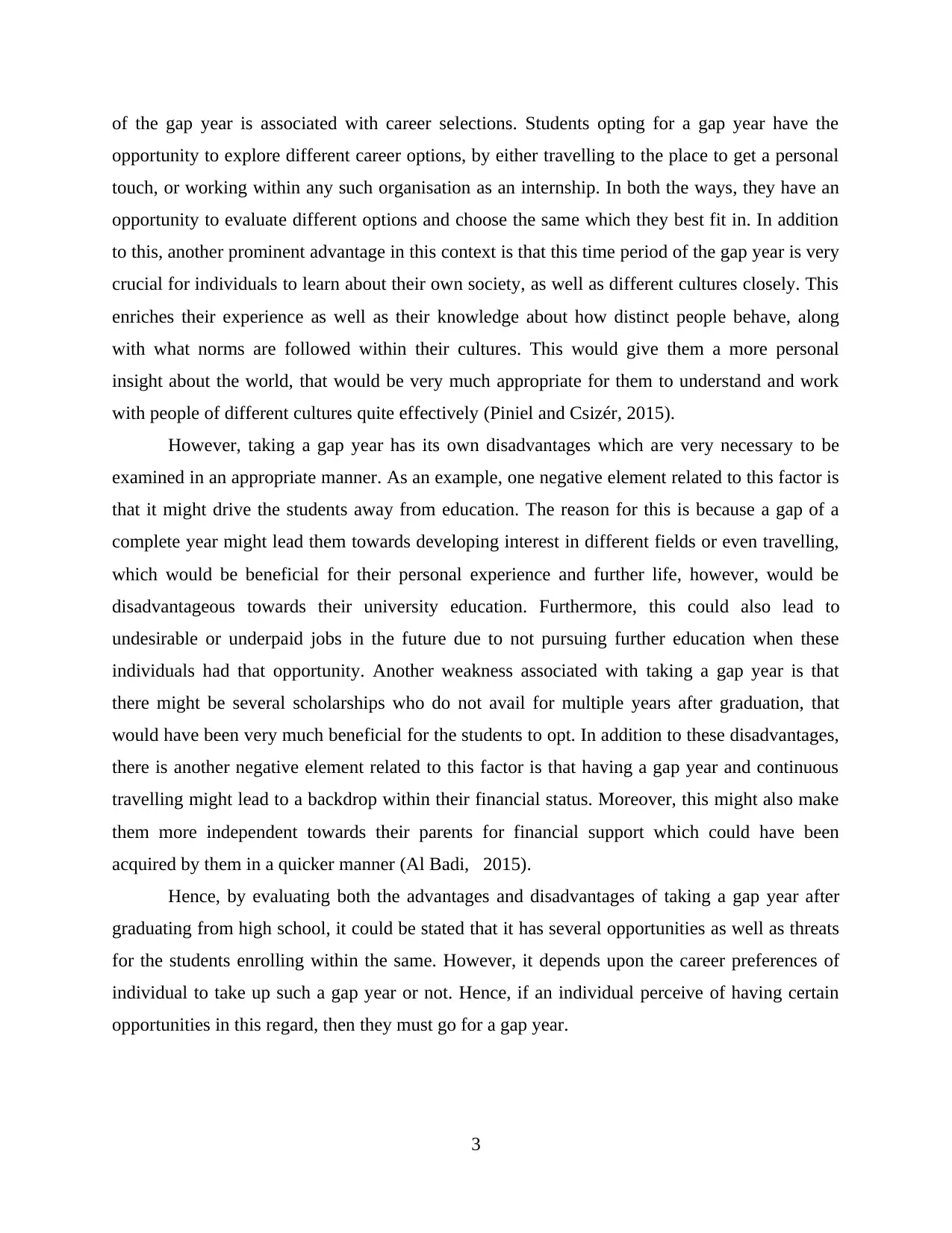
of the gap year is associated with career selections. Students opting for a gap year have the
opportunity to explore different career options, by either travelling to the place to get a personal
touch, or working within any such organisation as an internship. In both the ways, they have an
opportunity to evaluate different options and choose the same which they best fit in. In addition
to this, another prominent advantage in this context is that this time period of the gap year is very
crucial for individuals to learn about their own society, as well as different cultures closely. This
enriches their experience as well as their knowledge about how distinct people behave, along
with what norms are followed within their cultures. This would give them a more personal
insight about the world, that would be very much appropriate for them to understand and work
with people of different cultures quite effectively (Piniel and Csizér, 2015).
However, taking a gap year has its own disadvantages which are very necessary to be
examined in an appropriate manner. As an example, one negative element related to this factor is
that it might drive the students away from education. The reason for this is because a gap of a
complete year might lead them towards developing interest in different fields or even travelling,
which would be beneficial for their personal experience and further life, however, would be
disadvantageous towards their university education. Furthermore, this could also lead to
undesirable or underpaid jobs in the future due to not pursuing further education when these
individuals had that opportunity. Another weakness associated with taking a gap year is that
there might be several scholarships who do not avail for multiple years after graduation, that
would have been very much beneficial for the students to opt. In addition to these disadvantages,
there is another negative element related to this factor is that having a gap year and continuous
travelling might lead to a backdrop within their financial status. Moreover, this might also make
them more independent towards their parents for financial support which could have been
acquired by them in a quicker manner (Al Badi, 2015).
Hence, by evaluating both the advantages and disadvantages of taking a gap year after
graduating from high school, it could be stated that it has several opportunities as well as threats
for the students enrolling within the same. However, it depends upon the career preferences of
individual to take up such a gap year or not. Hence, if an individual perceive of having certain
opportunities in this regard, then they must go for a gap year.
3
opportunity to explore different career options, by either travelling to the place to get a personal
touch, or working within any such organisation as an internship. In both the ways, they have an
opportunity to evaluate different options and choose the same which they best fit in. In addition
to this, another prominent advantage in this context is that this time period of the gap year is very
crucial for individuals to learn about their own society, as well as different cultures closely. This
enriches their experience as well as their knowledge about how distinct people behave, along
with what norms are followed within their cultures. This would give them a more personal
insight about the world, that would be very much appropriate for them to understand and work
with people of different cultures quite effectively (Piniel and Csizér, 2015).
However, taking a gap year has its own disadvantages which are very necessary to be
examined in an appropriate manner. As an example, one negative element related to this factor is
that it might drive the students away from education. The reason for this is because a gap of a
complete year might lead them towards developing interest in different fields or even travelling,
which would be beneficial for their personal experience and further life, however, would be
disadvantageous towards their university education. Furthermore, this could also lead to
undesirable or underpaid jobs in the future due to not pursuing further education when these
individuals had that opportunity. Another weakness associated with taking a gap year is that
there might be several scholarships who do not avail for multiple years after graduation, that
would have been very much beneficial for the students to opt. In addition to these disadvantages,
there is another negative element related to this factor is that having a gap year and continuous
travelling might lead to a backdrop within their financial status. Moreover, this might also make
them more independent towards their parents for financial support which could have been
acquired by them in a quicker manner (Al Badi, 2015).
Hence, by evaluating both the advantages and disadvantages of taking a gap year after
graduating from high school, it could be stated that it has several opportunities as well as threats
for the students enrolling within the same. However, it depends upon the career preferences of
individual to take up such a gap year or not. Hence, if an individual perceive of having certain
opportunities in this regard, then they must go for a gap year.
3
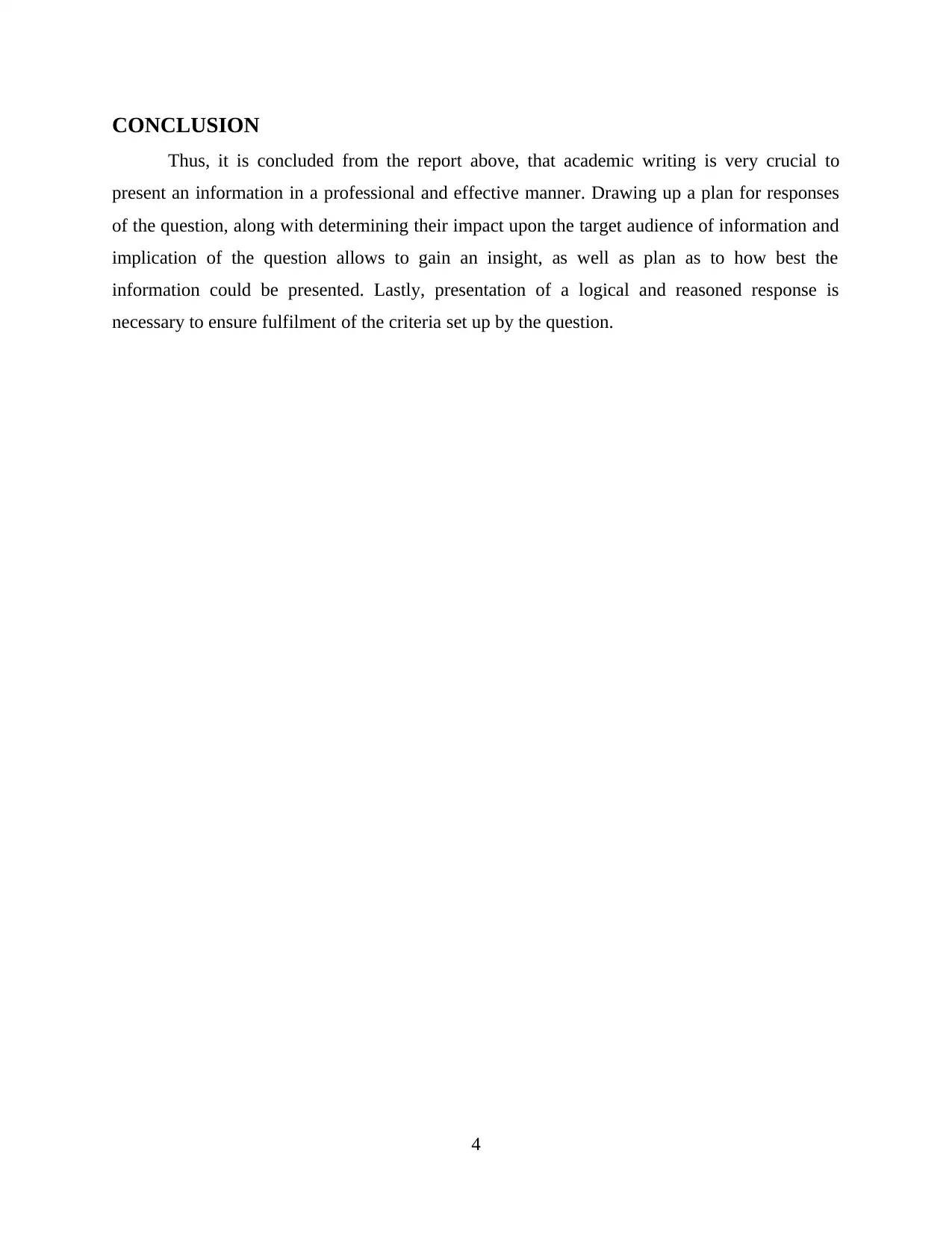
CONCLUSION
Thus, it is concluded from the report above, that academic writing is very crucial to
present an information in a professional and effective manner. Drawing up a plan for responses
of the question, along with determining their impact upon the target audience of information and
implication of the question allows to gain an insight, as well as plan as to how best the
information could be presented. Lastly, presentation of a logical and reasoned response is
necessary to ensure fulfilment of the criteria set up by the question.
4
Thus, it is concluded from the report above, that academic writing is very crucial to
present an information in a professional and effective manner. Drawing up a plan for responses
of the question, along with determining their impact upon the target audience of information and
implication of the question allows to gain an insight, as well as plan as to how best the
information could be presented. Lastly, presentation of a logical and reasoned response is
necessary to ensure fulfilment of the criteria set up by the question.
4
⊘ This is a preview!⊘
Do you want full access?
Subscribe today to unlock all pages.

Trusted by 1+ million students worldwide
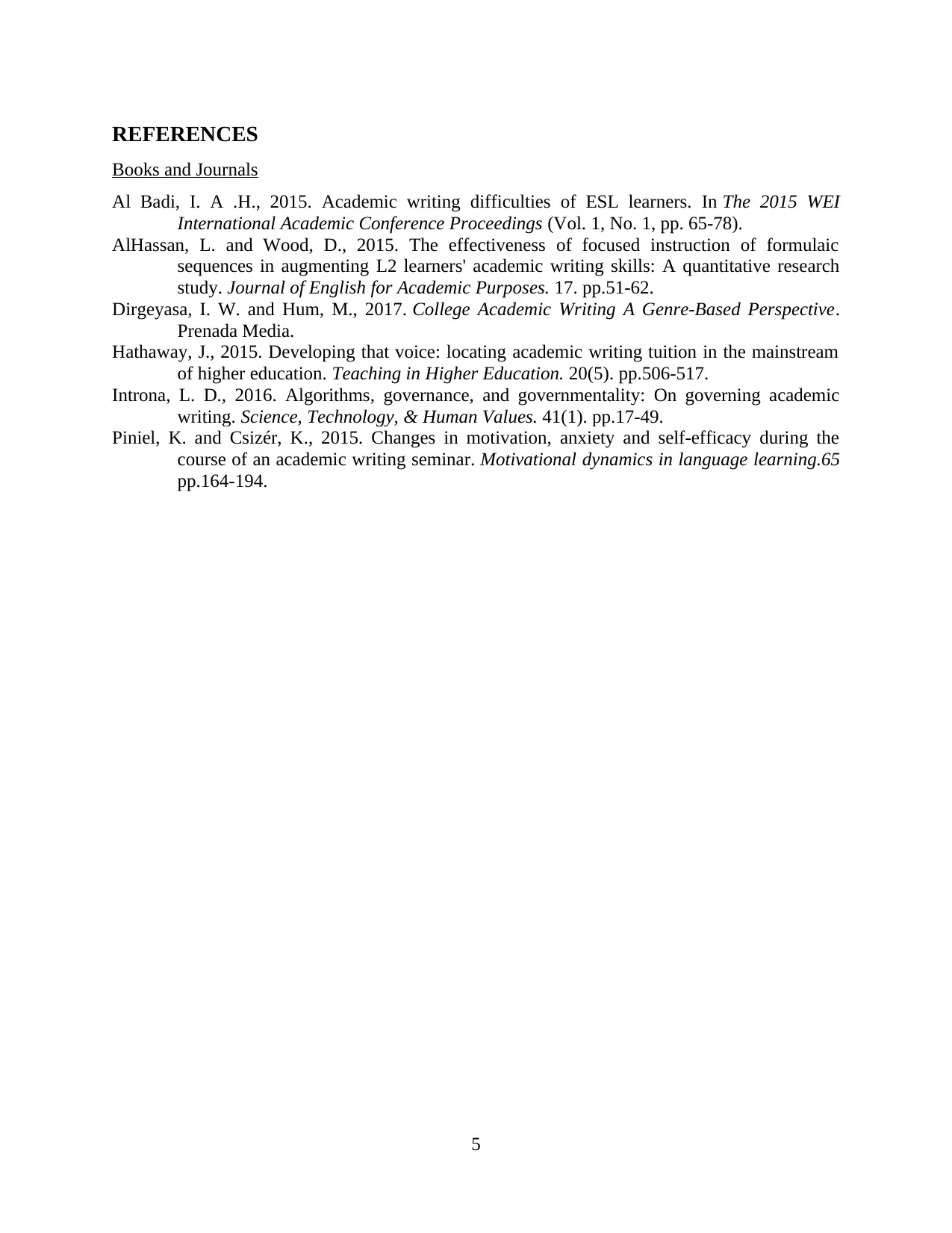
REFERENCES
Books and Journals
Al Badi, I. A .H., 2015. Academic writing difficulties of ESL learners. In The 2015 WEI
International Academic Conference Proceedings (Vol. 1, No. 1, pp. 65-78).
AlHassan, L. and Wood, D., 2015. The effectiveness of focused instruction of formulaic
sequences in augmenting L2 learners' academic writing skills: A quantitative research
study. Journal of English for Academic Purposes. 17. pp.51-62.
Dirgeyasa, I. W. and Hum, M., 2017. College Academic Writing A Genre-Based Perspective.
Prenada Media.
Hathaway, J., 2015. Developing that voice: locating academic writing tuition in the mainstream
of higher education. Teaching in Higher Education. 20(5). pp.506-517.
Introna, L. D., 2016. Algorithms, governance, and governmentality: On governing academic
writing. Science, Technology, & Human Values. 41(1). pp.17-49.
Piniel, K. and Csizér, K., 2015. Changes in motivation, anxiety and self-efficacy during the
course of an academic writing seminar. Motivational dynamics in language learning.65
pp.164-194.
5
Books and Journals
Al Badi, I. A .H., 2015. Academic writing difficulties of ESL learners. In The 2015 WEI
International Academic Conference Proceedings (Vol. 1, No. 1, pp. 65-78).
AlHassan, L. and Wood, D., 2015. The effectiveness of focused instruction of formulaic
sequences in augmenting L2 learners' academic writing skills: A quantitative research
study. Journal of English for Academic Purposes. 17. pp.51-62.
Dirgeyasa, I. W. and Hum, M., 2017. College Academic Writing A Genre-Based Perspective.
Prenada Media.
Hathaway, J., 2015. Developing that voice: locating academic writing tuition in the mainstream
of higher education. Teaching in Higher Education. 20(5). pp.506-517.
Introna, L. D., 2016. Algorithms, governance, and governmentality: On governing academic
writing. Science, Technology, & Human Values. 41(1). pp.17-49.
Piniel, K. and Csizér, K., 2015. Changes in motivation, anxiety and self-efficacy during the
course of an academic writing seminar. Motivational dynamics in language learning.65
pp.164-194.
5
1 out of 7
Related Documents
Your All-in-One AI-Powered Toolkit for Academic Success.
+13062052269
info@desklib.com
Available 24*7 on WhatsApp / Email
![[object Object]](/_next/static/media/star-bottom.7253800d.svg)
Unlock your academic potential
Copyright © 2020–2025 A2Z Services. All Rights Reserved. Developed and managed by ZUCOL.





